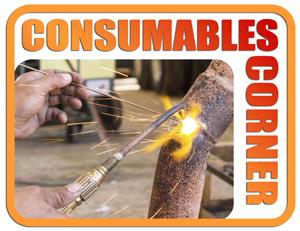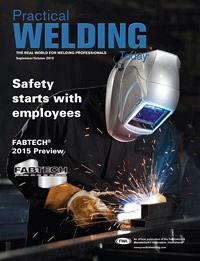Independent welding consumables professional
- FMA
- The Fabricator
- FABTECH
- Canadian Metalworking
Categories
- Additive Manufacturing
- Aluminum Welding
- Arc Welding
- Assembly and Joining
- Automation and Robotics
- Bending and Forming
- Consumables
- Cutting and Weld Prep
- Electric Vehicles
- En Español
- Finishing
- Hydroforming
- Laser Cutting
- Laser Welding
- Machining
- Manufacturing Software
- Materials Handling
- Metals/Materials
- Oxyfuel Cutting
- Plasma Cutting
- Power Tools
- Punching and Other Holemaking
- Roll Forming
- Safety
- Sawing
- Shearing
- Shop Management
- Testing and Measuring
- Tube and Pipe Fabrication
- Tube and Pipe Production
- Waterjet Cutting
Industry Directory
Webcasts
Podcasts
FAB 40
Advertise
Subscribe
Account Login
Search
Consumables Corner: Welding medium-carbon to high-strength steel
- By Nino Mascalco, Rob Koltz, and Steve Sigler
- September 28, 2015
- Article
- Consumables
Q: We need to weld a 1-in.-thick AISI 1050 carbon steel plate to a 2-in.-dia. A514 steel shaft. The AISI 1050 has a yield and tensile strength of 95 KSI and 115 KSI, respectively. We know we should preheat, but we're unsure of what temperatures to use or what filler metal to select. Could you please advise?
A: Here are some other important things to consider for this job.
Welding process, maximum interpass temperature, cooling rate after welding, and postweld heat-treat (PWHT) are all variables that need to be specified and controlled for this application.
Preheat and maximum interpass temperatures on the AISI 1050 steel are thickness- and carbon equivalency-dependent. If you have a material certification from the steel supplier, you can calculate the carbon equivalency (online calculators are readily available) to determine specifically what the temperatures should be. If you don't have this information, we recommend a preheat temperature of no more than at least 300 degrees F and a maximum interpass temperature of no more than 700 degrees F for a 1-in.-thick plate.
Since the A514 gets its properties from quenching and tempering, be sure you don’t overheat this material or you will degrade its mechanical properties. For the A514 shaft, it too is thickness- and/or grade-dependent. The minimum preheat temperature should be at least 175 degrees F, and maximum interpass temperature no more than 400 degrees F.
For preheating and maximum interpass temperatures, the A514 is the controlling material. When preheating, apply and achieve the preheat temperatures as recommended for the steel type (each base material side of the weld joint). The maximum interpass temperature during welding should not exceed 400 degrees F for the welded joint.
The AISI 1050 steel, depending upon carbon equivalency, may benefit from a PWHT application; however, it is not recommended that the A514 steel be used in the PWHT condition. Therefore, it’s best that no PWHT process be used for this application, but it is still important for you to control the postweld cooling rate. After you complete the application, try submersing the hot welded parts in a dry medium, such as a clay floor or dry sand, or cover the parts with a ceramic or fiberglass insulating blanket.
When choosing a filler metal, don’t try to overmatch the filler metal strength to the base material strength. In fact, if the application is limited to a single-pass weld, there will be some alloy recovery from the base material during welding, which may slightly increase the strength of the weld joint.
The A514 should have a yield strength of at least 100 KSI and a tensile strength of 110 to 130 KSI for this material thickness.
For this application, we recommend a filler metal from the E110 classification. The welding process used is not critical for weld soundness or strength, but it should be a low-hydrogen process (H4 designation). Welders should use a stringer-bead technique and make sure the joint is free of rust, mill scale, paint, and any other impurities.
About the Authors


Rob Koltz
Application Engineer
411 S. Ebenezer Rd.
Florence, 29501
636-485-2253
Steve Sigler
Application Engineer
411 S. Ebenezer Rd.
Florence, South Carolina 29501
636-485-2253
About the Publication
Related Companies
subscribe now

The Welder, formerly known as Practical Welding Today, is a showcase of the real people who make the products we use and work with every day. This magazine has served the welding community in North America well for more than 20 years.
start your free subscription- Stay connected from anywhere

Easily access valuable industry resources now with full access to the digital edition of The Fabricator.

Easily access valuable industry resources now with full access to the digital edition of The Welder.

Easily access valuable industry resources now with full access to the digital edition of The Tube and Pipe Journal.
- Podcasting
- Podcast:
- The Fabricator Podcast
- Published:
- 04/16/2024
- Running Time:
- 63:29
In this episode of The Fabricator Podcast, Caleb Chamberlain, co-founder and CEO of OSH Cut, discusses his company’s...
- Trending Articles
Sheffield Forgemasters makes global leap in welding technology

ESAB unveils Texas facility renovation

Engine-driven welding machines include integrated air compressors

The impact of sine and square waves in aluminum AC welding, Part I

Compact weld camera monitors TIG, plasma processes

- Industry Events
16th Annual Safety Conference
- April 30 - May 1, 2024
- Elgin,
Pipe and Tube Conference
- May 21 - 22, 2024
- Omaha, NE
World-Class Roll Forming Workshop
- June 5 - 6, 2024
- Louisville, KY
Advanced Laser Application Workshop
- June 25 - 27, 2024
- Novi, MI



























